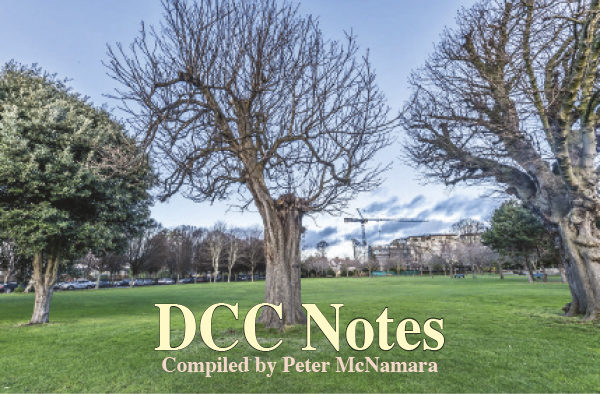
South East Area Committee Meeting
Monday, October 14th
The meeting was chaired by Cllr Dermot Lacey (LAB). The meeting began with a rather unusual turn of events. Due to other professional obligations, Cllr Chris Andrews (SF) was allowed to break agenda protocol and chair an emergency motion at the very start of the meeting.
The motion concerned local staffing. He highlighted how, due to cutbacks, the area has lost two dedicated managers who have not been replaced. He also noted how several administrative staff have also been lost without replacement. “People have been ringing from Pearse House, Mercer House,” according to Andrews. “It’s a huge inconvenience, frustrating for councillors, residents, and the staff trying to cover the gaps.”
Andrews recommended a report be produced every six months, detailing staff coming and going. He also wondered if staffing levels in Dublin Bay South were the same as in other areas, and recommended that this could be something to look into as well. The emergency motion was carried.
Collins’ Wood housing
Following on from this was a presentation by the Royal Hospital Donnybrook Housing, a voluntary housing body, and its proposed development at Collins’ Wood.
Derek Scally (the voluntary chair of RHDH) presented with Oonagh Ryan and Peter Lynch. They outlined their plans to build housing for vulnerable, elderly, or people with mobility issues, at Collins’ Wood. Several councillors expressed great approval of RHDH’s previous build at Beech Hill. Talk turned to how to maximise the potential of the project by building apartments to four storeys. Cllr Pat Dunne inquired about the housing application process to be used, and was told by Mr. Scally applications would be taken from suitable candidates (elderly/vulnerable) through the Dublin City Council housing list.
This was followed by a presentation on Dublin City’s Parks Strategy, by landscape architect Kieran O’Neill. Cllr Anne Feeney (FG) had questions about disability access, and whether smaller, inner city, green spaces were part of the plans, noting a complete lack of green space in Dublin 8. Cllr Hazel Chu (GP) and Cllr Patrick Costello (GP) echoed her concerns about such ‘pocket parks’, pointing to the positive effect they have on local biodiversity, and their success in cities like Paris and New York.
Regarding disability access, O’Neill stated this was an important aspect of the strategy’s design. He also noted that the Disability Access Assessment for the parks had been done over a decade ago, and, most likely, needed to be revised. Regarding the smaller green spaces, he pointed to new spaces in the Docklands, and said that by improving the quality of the inner city streets, and upgrading their greenness in other ways, you could compensate for actual green space. He also noted that many suburban parks are large and empty, and will need to be upgraded to attract more users.
Cllr Pat Dunne, Independents 4 Change, (I4C) called for a return to pre-austerity levels of park staffing. Cllr Pat McCartan (FG) inquired about gaining public access to Fitzwilliam Park, noting that the idea of a resident’s park “goes back to the days of grandiose Dublin” and is no longer acceptable. He was informed the Fitzwilliam Association has a 150-year lease on the park, which was granted in the 1970s, but that the DCC “will still promote and seek to gain access.”
Cycling and pedestrianisation
Cllr Tara Deacy (SD) and Cllr Claire Byrne (GP) both tabled motions relating to safe cycling. Deacy called for a comprehensive review of the cycling network, and sought protected cycling lanes. Byrne noted how the different nubs/barriers could help segregate the cycle lanes from traffic in the meantime, but that proper funding was required. She also noted – and was supported by Cllr Dermot Lacey – the “appalling” breaches of the law on Ranelagh road, where, on each evening, cars park on the footpath and the cycle lanes.
Cllr Byrne tabled a further motion relating to the bike parking facilities for park and ride DART users. Given the conditions for cyclists in the area at the moment, she noted that “these people are risking their lives to commute and their needs are coming second to those attending matches and the like” at the Aviva stadium. She called for a rejection of the official report on the matter and asked for the situation to be reviewed again. Cllr Lacey (LAB) echoed her concerns, and the rejection was agreed.
Cllr Costello (GP) tabled a motion to pedestrianise South William Street, Drury Street and Dame Court. “With simple changes,” he said, “we can massively increase pedestrianisation, and preserve access to car parks. It could be a quick win, making the south inner-city much nicer for locals and tourists.”
Removal of trees on Herbert Park Avenue
Works are proposed to thin and entirely remove a number of trees along Herbert Park Avenue. There are 145 trees in this area. 68 will be removed, 28 will be replaced, and 80 will be unaffected. The councillors seemed to generally agree that the proposal was “in the name of good park management and good agricultural practices,” and that certain trees were causing problems on the footpaths. The trees that are to be replaced will be replaced by oak, which is in keeping with good biodiversity practice.
Speaking on the matter, Cllr McCartan (FG) noted how people are attached to trees, pointing to the recent uproar at the Bus Connects proposals. He noted how it can be difficult to convince them of the need to cut them down, and said it was important to “bring people with us.” On this point, Cllr Costello (GP) asked whether there were plans for any notice boards in the area, to let people know, “we’re removing them for the right reasons.” Likewise, Cllr Lacey (LAB) highlighted the need to prepare people, so that they weren’t “suddenly met by fellahs with chainsaws.”
Extinction Rebellion and not thanking Covanta
Cllr Mannix Flynn (IND) raised a question about the encampment by climate protestors Extinction Rebellion in Merrion Square Park. This protest group set up some 30 tents in the park as part of the international ‘Rebellion Week’ demonstrations.
“Who gave a permit for the encampment,” asked Cllr Flynn. “What damage was done? And at what costs?” The councillor was quick to note the wide support for the movements, saying he was himself “of that persuasion.” In reply, Cllr Lacey (LAB) said he would look into the matter, but “would have been disappointed if they’d asked for permission!”
At this recent meeting, Cllr Lacey also encouraged people to stop thanking Covanta for the contributions they make to different local projects and funds. “They’re not doing this out of the goodness of their heart,” he said, reminding the chamber that giving this financial support was a condition of their planning permission due to the imposition of the incinerator. “If you’re acknowledging the funding they give,” he went on to say, “make sure in the same speech you acknowledge their wonderful contribution to pollution in the area.”
Repatriating Joyce, razing Glovers’ Court, and Sandymount stink
James Joyce was born in Brighton Square, Rathgar, in 1889, and died in Zurich, Switzerland, in 1941. Cllr Pat McCartan (FG) proposed that in 2021, on the 100th anniversary of the publication of Joyce’s ground-breaking Ulysses, the writer should be repatriated to his native Ireland. Cllr McCartan noted that, while exile was a fact of Joyce’s life on earth, “it should not follow him into eternity.” Plans were discussed to contact the President, Michael D. Higgins on this matter, and the motion was carried.
Cllr Mannix Flynn (IND) tabled a motion to fast track demolition of the deteriorating Glovers’ Court. He noted how the place was dilapidated, with widespread rot and water leakage. “Children’s chests are infected,” he told the chamber, “and the elderly find it very hard to navigate the place.” According to Cllr Flynn, added to this, youths from other areas are causing havoc on a nightly basis. “It’s like a jail,” he said. “We need to send a clear message to the DDC to pay more attention to the block.” Ultimately, Cllr Flynn proposed the complete removal of the buildings, with replacement housing to be built on the site.
Cllr Claire Byrne (GP) supported the proposal, noting that, due to the severity of the degradation of the buildings, the only option was to rehome residents and rebuild the place entirely. “Right now we’re only papering over the cracks,” she added. Plans were made to contact the Minister for Housing, and the motion was carried.
Discussion also turned to the foul odour on Sandymount Strand. Cllr Dermot Lacey (LAB) raised a motion to demand a report on the issue. “It’s unprecedented,” he said, “like nothing I’ve known in the area before.” He noted how the Area Manager had reassured him it was natural, but he refused to accept this response. “Interventions that can be made, should be made.” He noted that given the leakages from the sewage plant, it was quite likely a new kind of fungus/growth had taken hold. “A proper report,” he said, “will help restore public confidence and should be funded.” The motion was carried.



